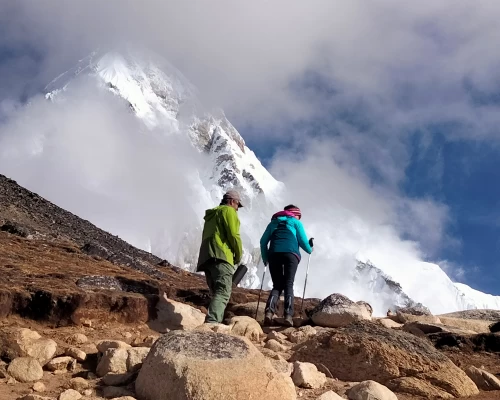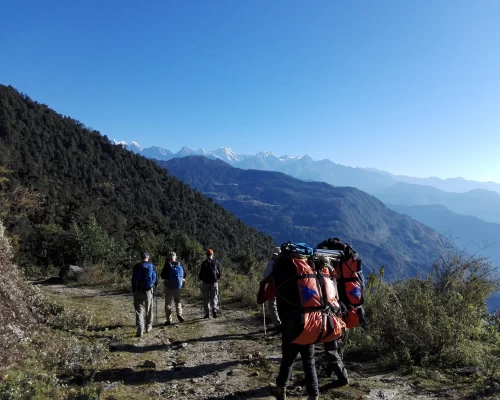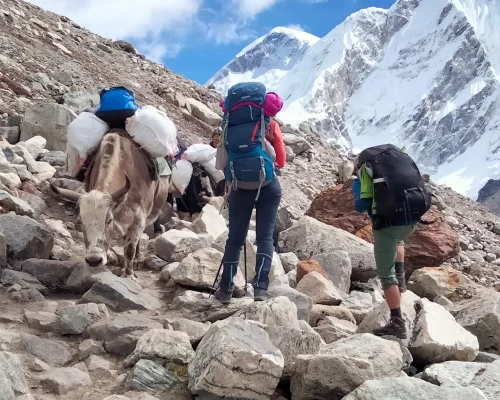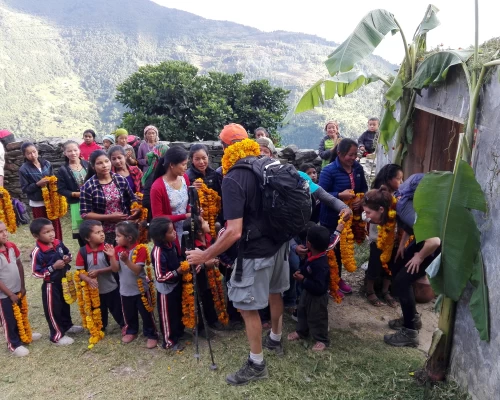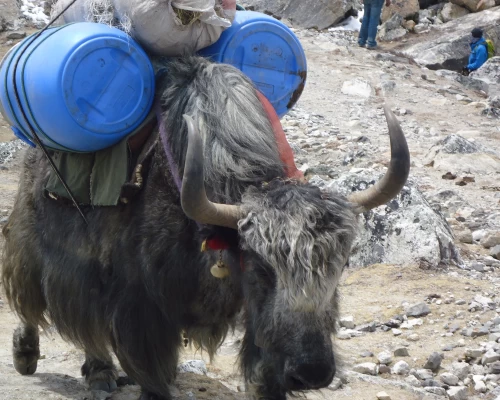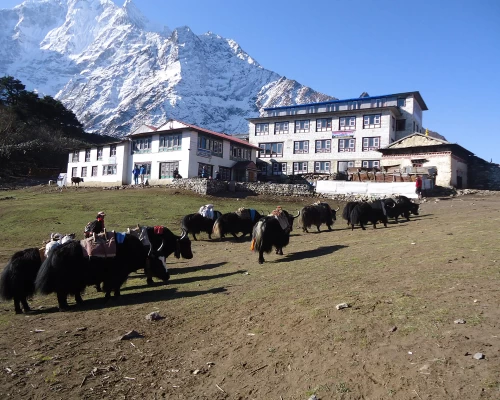Transportation: Overland Vehicle from KTM to Salleri Bazaar- then change to a local 4x4 jeep to Thamdanda (the driving will be rough, tough, and adventurous). On the way back, you will fly by domestic flight from Lukla to Ramechhap and a 4-hour vehicle drive to Kathmandu.
Walking Trails: In some parts, trekkers must walk on the road, but alternative walking trails are adequately available everywhere. There is an ancient legendary walking trail from Surke to EBC and return to Lukla. The trail is often gradual up until you reach EBC and Kalapatthar. Crosses Rivers, glaciers, alpine contours, highlands, and rocky plateaus.
Trek hours per day: The itinerary is always eligible; every day your trek starts after breakfast. Take your own speed and enjoy your walking and the views. Normally, walking hours will be 4-8 hours a day. You may take a longer time than you expect to complete your ultimate mission around Gorakshep and EBC.
Landscape & temperature: The landscape on this trek is very amazing. It starts at a lower and warmer greenery region and ends at a highland. Terraced field, beautiful hill and hillock, glaciers, moraine, and High Mountains. Warm in the lower land but dry, windy, and cold atmosphere at the higher land. The big and sky-touching mountains stand on every side in the Himalayas. It is warm during the day and will be cold at night. The coldest night will be at Gorakshep, but it depends on the Season.
Amazing things to see
The highest mountain in the world, Everest, is 8,848 meters, Lhotse is 8,516 metres, Lhotse Shar is 8,383 meters, and Makalu is 8,485 meters. The most beautiful mountain, Amadablem 6,812 meters of Nepal. The famous trekking peak, Island Peak 6,100 meters. The world’s highest Khumbu glacier. The world’s famous Khumbu Icefall, the legendary EBC basecamp, and the famous Tyangboche Monastery. The Yeti's skull at Khumjung Monastery.
Maximum Altitude
The highest overnight place is 5,170 Meters at Gorakshep, the highest destination is 5,545 meters at Kalapathar, and the 5,360 Meters excursion at Everest Base Camp.
Altitude sickness
Altitude sickness (acute mountain sickness) is difficulty sleeping, dizziness, headache, fatigue, loss of appetite, rapid pulse, nausea, vomiting, etc. It affects mountain climbers, hikers, and skiers because of lower air pressure and lower oxygen levels. It occurs as the result of failure to adapt at a higher altitude. It happens most often in the brain or the lungs after the fluid begins to leak from the blood vessels.
When the fluid collects in the brain, you initially get headaches, loss of appetite, nausea, tiredness, a desire to lie down and feel powerless, physically moving is unwilling, a decrease in consciousness, and the problem with balance coordination is called high–altitude cerebral edema (HACE). If the fluid is collected in the lungs, you become breathless and dry, and it makes a regular irritative cough, sometimes coughing up blood too, discoloration of the skin, and chest tightness is called high altitude pulmonary edema (HAPE).
Prevention
To prevent acute mountain sickness, we have to follow fundamental gravity habits such as patience, consistency, and discipline in the mountains. The mountains have their own rule and regulations. We cannot turn them into our nature except by following and respecting them. Cloth properly according to the altitude, avoid rapid altitude gain, drink enough water or fluid, take enough acclimatization time to adjust the body at a higher altitude, avoid alcoholic items, control smoking, eat regular meals, get higher & sleep at lower altitudes. Avoid high altitudes if you have heart and lung disease. If the symptoms occur heavily, then stop detting altitude descend to a lower altitude.
In case the person is seriously sick, or cannot bring him/her to a lower altitude by walking and carrying, then she/he should be rescued by a quick Helicopter evacuation.
Clothing Equipment:
Lightweight walking boots, a pair of track shoes, and slippers to wear in the evening or when the boots are wet.
Warm jacket (Fibers fill or down should be adequate.)
A Rainproof jacket with a hood or poncho.
Warm clothes or fleece jackets.
Thin and thick trousers.
Warm trousers are useful higher up in the mountains in the morning and at night. (Windproof/ waterproof trousers are necessary during treks going above 3000 m)
Thermal underwear (This is excellent for sleeping at night)
A pair of loose-fitting long shorts and 1 lightweight long-sleeved shirt are particularly suitable for avoiding sunburn.
A woolen or warm hat to wear in the morning and at night. Sunhat and ensure it has a wide brim to cover the face and neck.
A pair of gloves (warm and normal ones)
2 pairs of thin and 2 pairs of thick warm socks.
Underwear, buff, and hankies as you need.
Accessories
A duffle bag or kit bag to carry your gear while trekking, sleeping bag. Small rucksack to carry personal requirements for the day, e.g., toilet paper, towel, soap, etc. Water bottle. Snow glasses and sunglasses, 2-4 large plastic bags to separate clean clothes from dirty ones. Headlamp with spare batteries, sun cream, personal medicine, lip guard, toothbrush, towel, Reading materials, game items (optional), notebook, rubber band, pen and pencil, a diary, a pocket knife, trekking map, passport, and copies.
Drinking Water
Travelers should be very aware of drinking water in Nepal. They are not completely adapted to digest direct normal spring water due to the bacteria. So, we recommend you drink mineral water or boiled water. Also, you can use some purifier tablets, such as chlorine tablets, for purifying water on the trek. We strongly recommend mineral water in the city area and purified or boiled water for trekking.
Accommodation
We provide accommodation according to your demand and accessibility, either normal standards or comfortable luxury hotels in the City. We provide very neat, clean, and comfortable hotels, lodges, friendly homestays, or, locally, what is available for the most suitable on the trek. The dining room will be heated with firewood or yak dung in the center of the room.
Our Contact:
Mobile and WhatsApp: +977 9841265786 (Sanga)
Email: [email protected], [email protected]



